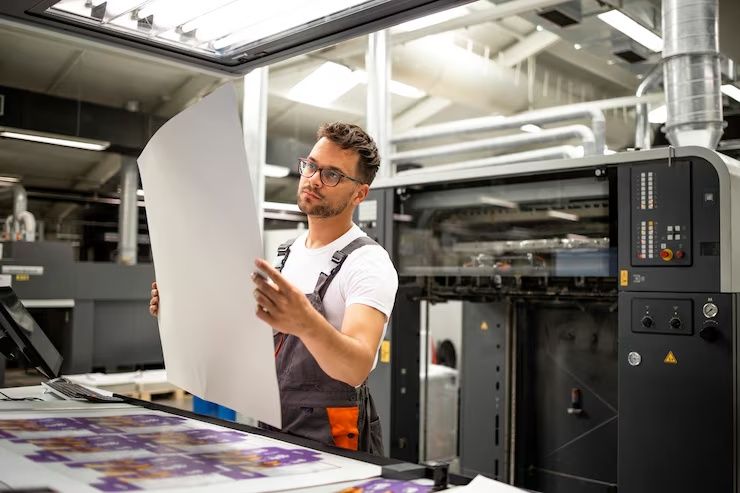Printing machines are important devices used to transfer textual content, photos, and designs onto paper, fabrics, packaging, and different substances. The origins of printing can be traced again to woodblock printing in historic China, evolving to Gutenberg’s printing press within the fifteenth century, which revolutionized mass conversation.
Today, printing machines are available in many forms, which include digital printers, offset presses, 3-D printers, and specialized textile and packaging machines. Their position extends beyond publishing books and newspapers into industries which include production, advertising and marketing, training, healthcare, and packaging. With digitalization and automation, printing machines have turn out to be extra versatile, green, and sustainable.

Importance
Understanding print machines is important due to the fact that they affect more than one region of the day of the existence of day and enterprise.
Communication and school education:
Schools, universities and publishers rely on print machines to offer books, study materials and research magazines.
Packaging and marking:
Food, prescribed medicines and consumables depend on industry labels and spectacular printing for safety figures.
Advertisement and branding:
Printing machines are used for banners, posters and brochures connecting companies with customers.
Industrial and production use:
Special machines Print Circuit Forums, Textiles and 3D-knit components for ERA and Healthcare.
Stability:
Green ink and power -green printing technology guides promote environmental goals around the world.
Recent updates
Printing Enterprise has massive technological progress in 2023-2024.
Digital changes: Digital printing is constantly increasing, rapid turnout and customized production.
Three D printing growth: Production, health services and construction have increased in using a 3D printer, a 17% market boom with reports in 2023 has been shown.
Eco-dry print: Companies begin to biodegradable ink and recycled paper to reduce the environmental impact.
Smart automation: Modern print machines combine AI-dispensed quality control and future maintenance systems.
Hybrid technologies: Printers that combine displacement and virtual abilities are known for balanced price efficiency and versatility.
Global calls for packaging: With the growth of e-trade in 2023-2024, packing of print machines especially a strong bounce in Asia and North America.
These updates show how print machines are adapted to digital needs, permanent practice and global business symptoms.
Laws or guidelines
The use of print machines is motivated through rules that promote safety, stability and direct business.
Environmental policy: Many governments affect chemical-main-based ink, encouraging the amount of water based or biodegradable alternatives.
Intellectual Property Act: Copyright and Trademark Security must be taken on the printed material to prevent fractures.
Workplace protection standards: Rules ensure stable operation of large print equipment in factories.
Energy efficiency application: Governments in regions along the EU and South Korea encourage generations of power saving.
Waste Control Regulations: Printing Industries must follow the guidelines for recycling for waste waste.
These frameworks ensure that the printing business is safe, moral and environmentally responsible.
Tools and resources
A series of equipment and systems supports people and groups run with print machines.
Design software: Adobe Illustrator, Coradra and Canva Assist put together printed-tailed designs.
Color Herfer System: Pantone and ICC Color profiles Be sure to make regular prints great.
Maintenance apps: Tools that track print devices Basic performance and time table prevention care.
Sources of Education: Organizations such as Printing Industries of USA and FespA held research, webinars and training materials.
Online Calculator: Calculators require printing fees and paper help to plan large projects.
3D print point: Platforms such as Thingvies provide downloadable designs for adorable production.
| Printing Machine Type | Key Features | Applications |
|---|---|---|
| Offset Printer | High-quality, bulk printing | Books, magazines, newspapers |
| Digital Printer | Fast, customizable output | Marketing materials, short runs |
| Screen Printer | Thick ink application | Posters, fabrics, ceramics |
| Flexographic Printer | Roll-based printing | Packaging, labels, corrugated boxes |
| 3D Printer | Layer-by-layer fabrication | Prototypes, medical devices, aerospace |
FAQs
What are the most important variants of print machines?
The maximum general type includes shift printers, digital printers, screen printers, flexographic printers and 3D printers. Each industries perform specific features.
How do print machines develop with generations?
Modern machines combine AI, automation and green ink, while 3D printing is expanded with advanced production and health care.
Are printing machines durable?
Yes, stability becomes a relevant awareness, with biodegradable ink, recycled materials and up the strength-capable system.
Which industries are most dependent on print machines?
Publishing, packaging, advertising, textiles, production and health services are very dependent on printing technology.
Does print machines require regular maintenance?
Yes, preventive maintenance guarantees the first class, the system extends the life and reduces downtime.
Conclusion
Printing machines continue to be a cornerstone of conversation, manufacturing, and modern-day layout. From traditional offset presses to superior 3-d printers, those technology maintain to conform with digital transformation and sustainability at the leading edge.
Recent advancements which include green substances, hybrid technologies, and AI-pushed automation are reshaping how printing is integrated into industries global. With regulations guiding environmental obligation and workplace protection, the printing region is placed to stability innovation with duty.
By information printing machines, their makes use of, and the ultra-modern tendencies, individuals and agencies can higher recognize their impact on education, communication, and worldwide industry progress.